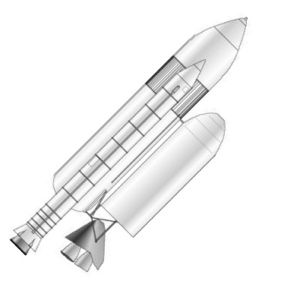
Home - Search - Browse - Alphabetic Index: 0- 1- 2- 3- 4- 5- 6- 7- 8- 9
A- B- C- D- E- F- G- H- I- J- K- L- M- N- O- P- Q- R- S- T- U- V- W- X- Y- Z
Boeing SDV
 Shuttle SDV 1977 Credit: © Mark Wade |
Status: Study 1977. Payload: 91,000 kg (200,000 lb). Gross mass: 922,000 kg (2,032,000 lb). Apogee: 300 km (180 mi).
Boeing was awarded NASA contract NAS8-32398 on 28 July 1977 to study unmanned cargo derivatives of the shuttle. The Class I vehicle would be similar to the Shuttle-C, using the shuttle aft fuselage with SSME engines to power a cargo canister into orbit. The engine pod would be recovered, and the payload shroud would be 7 m in diameter and 29 m long (allowing payloads up to 20.9 m long. A stretched shroud would be 38 m long and accommodate 30 m payloads. Both integral and separable engine pod variations were explored, resulting in payloads between 59,000 kg and 91,000 kg. A three-SSME version could but 91,000 kg into orbit and would have a gross liftoff mass of 922,000 kg. A four SSME version could put 102,000 kg into orbit with a gross liftoff mass of 975,000 kg. The propulsion module was to be designed for 300 flights. Development cost was estimated at $930 million, and first article cost for the engine pod $135 million. Cost of expendable items per flight was estimated at $4.23 million, with total cost per flight $14.136 million, or $1118 per kg to orbit, as opposed to the $1323/kg expected for the basic shuttle at that time.
Class II designs used a payload fairing 8.31 m in diameter, with a single liquid rocket booster, and 4 SSME engines uprated to 308,000 kgf and using a 2.9:1 oxidizer/fuel ratio. These would be rated for 50 flights between overhaul. The booster would have a gross liftoff mass of 1,130,000 kg, and be capable of placing 91,000 to 135,000 kg into orbit. The new booster would cost $2.863 billion to develop, with the first article costing $241 million. Cost per flight was expected to be $13.437 million, $ 4.38 million of that for expendable items, resulting in a cost per pound to orbit of $593.
LEO Payload: 91,000 kg (200,000 lb) to a 300 km orbit at 28.50 degrees.
Family: orbital launch vehicle, Winged. Country: USA. Agency: Boeing.
Back to top of page
Home - Search - Browse - Alphabetic Index: 0- 1- 2- 3- 4- 5- 6- 7- 8- 9
A- B- C- D- E- F- G- H- I- J- K- L- M- N- O- P- Q- R- S- T- U- V- W- X- Y- Z
© 1997-2019 Mark Wade - Contact
© / Conditions for Use